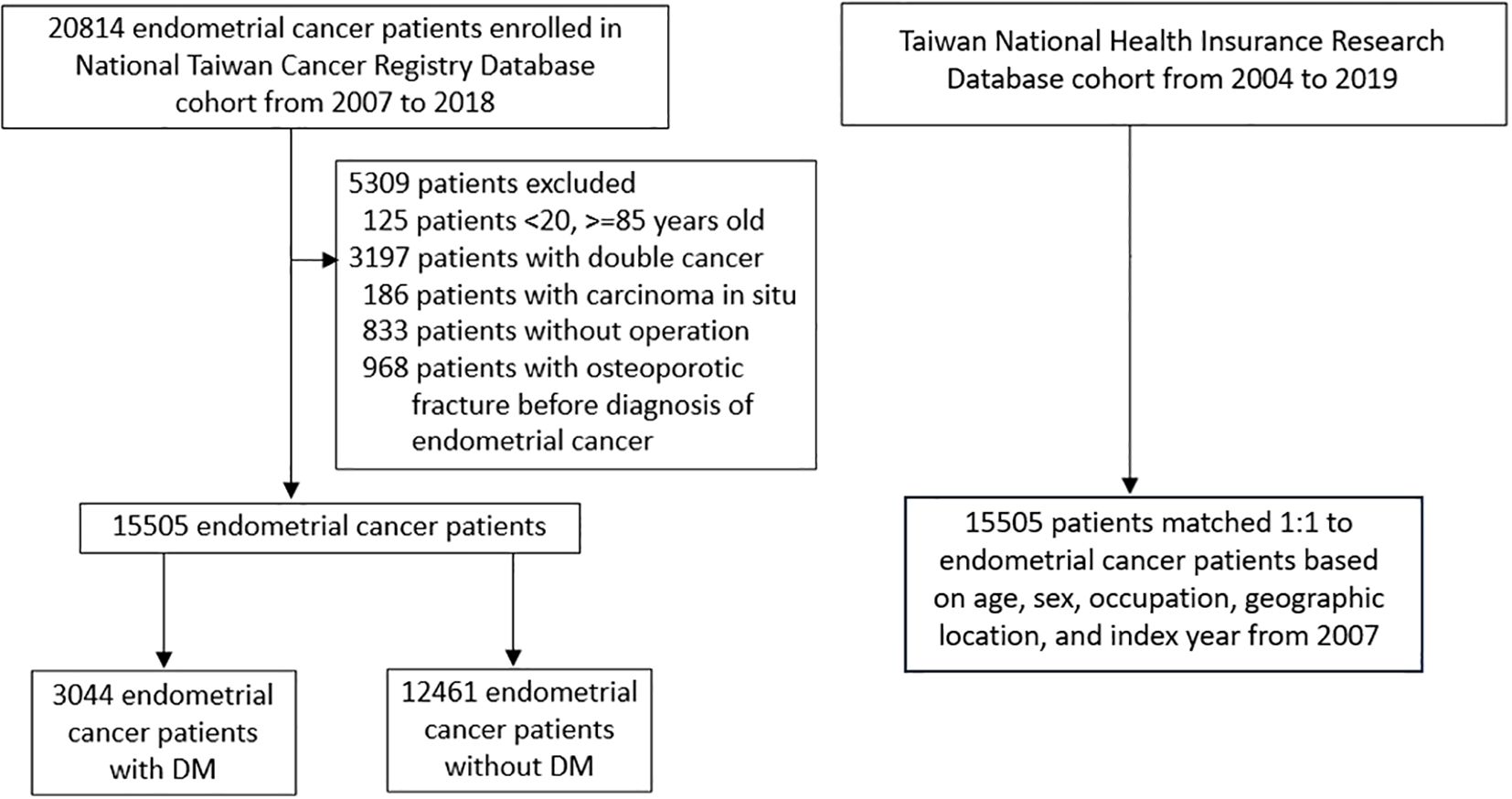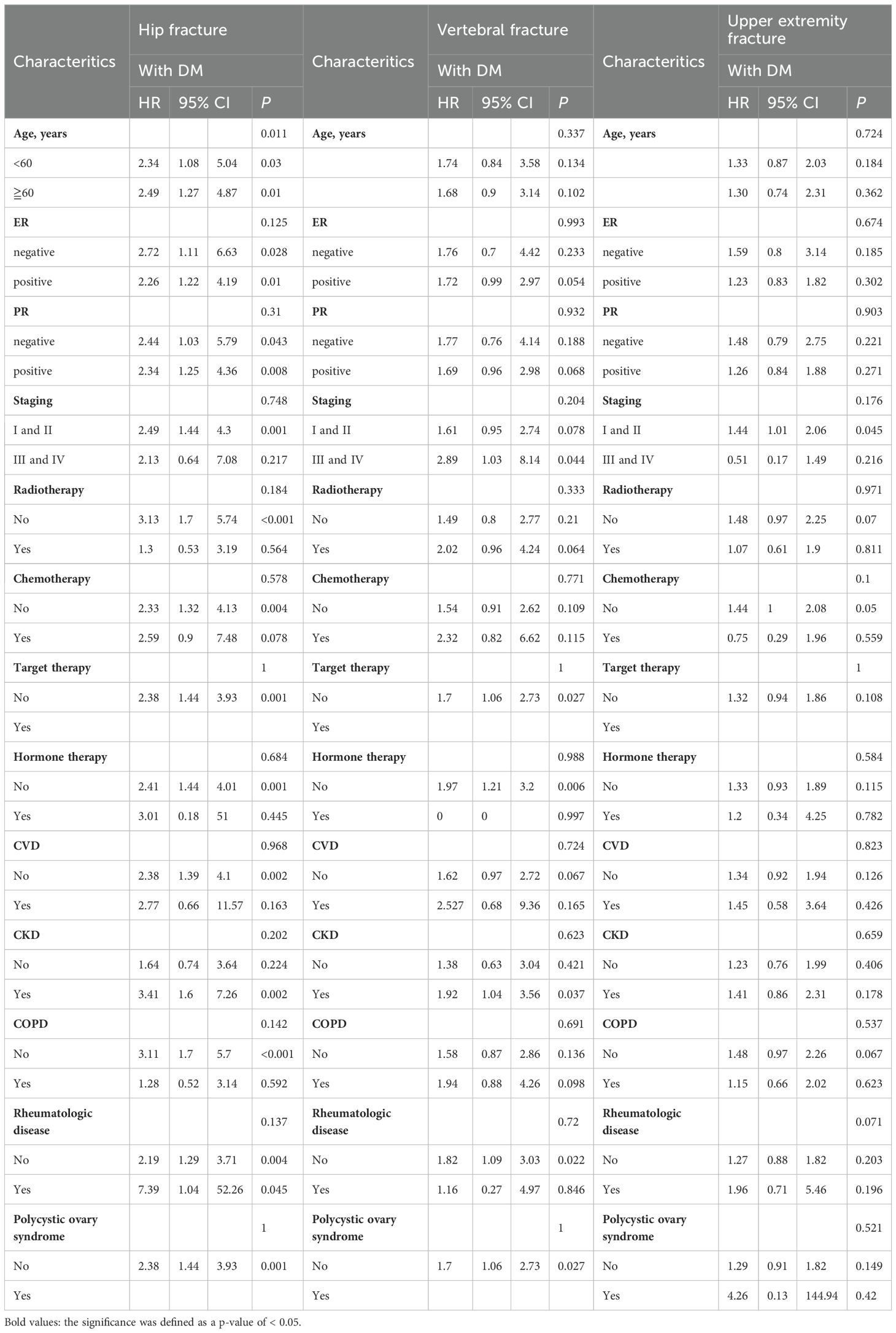- 1Division of Endocrinology and Metabolism, Department of Internal Medicine, MacKay Memorial Hospital, Taipei, Taiwan
- 2Department of Medical Research, MacKay Memorial Hospital, New Taipei, Taiwan
- 3Department of Gynecology and Obstetrics, MacKay Memorial Hospital, Taipei, Taiwan
- 4Institute of Epidemiology and Preventive Medicine, College of Public Health, National Taiwan University, Taipei, Taiwan
- 5Department of Medicine, MacKay Medical Collage, New Taipei, Taiwan
- 6Department of Family Medicine, Taipei MacKay Memorial Hospital, Taipei, Taiwan
- 7Department of Epidemiology, University of California, Los Angeles, Los Angeles, CA, United States
- 8Department of Family Medicine, Hsinchu MacKay Memorial Hospital, Hsinchu, Taiwan
- 9Department of Internal Medicine, National Taiwan University Hospital, Taipei, Taiwan
- 10Population Health Research Center, National Taiwan University, Taipei, Taiwan
Aims: Most endometrial cancer (EC) cases are estrogen-dependent, and some are associated with diabetes mellitus (DM). We aimed to estimate the risk of fracture among patients with EC and those with DM.
Materials and methods: A total of 20814 patients with EC were identified from the Taiwan National Cancer Registry from 2007 to 2018, with the outcome ascertainment using the National Health Insurance Research Database from 2004 to 2019. This observational study investigated the hazard ratios (HRs) for fracture and mortality events using Cox proportional hazards regression, with 95% confidence intervals (CIs). We adjusted baseline comorbidities, cancer therapy, cancer staging and grade, and pathological status of estrogen receptor and progesterone receptor. Considering the competing death events, we estimated the subdistribution hazard model to predict the probability of the fracture risk in the competing risks context.
Results: Among 15,505 EC patients, there were 3,044 patients with and 12,461 patients without DM. Patients with EC exhibited a no significant association of fracture when compared to the matched general population. EC patients with DM, compared to those without DM, had a significantly increased odds of osteoporotic fracture (HR 1.29 [95% CI 1.08–1.55]), hip fracture (HR 2.37 [95% CI 1.44–3.92]), and vertebral fracture (HR 1.71 [95% CI 1.06–2.74]). Patients with DM had a no significant association of upper extremity fracture (HR 1.33 [95% CI 0.95–1.87]) compared with those with EC but without DM.
Conclusions: EC patients had a no significant association of fracture, while DM increased the fracture risk in EC patients.
Introduction
With the recent rise in incidence, endometrial cancer (EC) has become the leading gynecological cancer in developed countries (1). According to the notable symptoms, most patients are diagnosed at an early stage, accounting for 70% of endometrial cancer (2). Despite the relatively favorable prognosis, with a 5-year overall survival of 77% (3, 4), 25% of patients die for recurrent endometrial cancer within 5 years since diagnosis (2). Since most patients with EC will be long-term survivors, whether these patients will have different comorbidities from those without EC is a question of particular interest.
Bone loss has been associated with various cancer therapies (5, 6). Previous research on the lumbar spine bone mineral density (BMD) in patients with gynecological cancer demonstrated a positive correlation with body mass index (BMI) (7), but a negative correlation with the age of patients (7). As most EC cases are estrogen-dependent, a rapid decrease in estrogen may cause abrupt changes in BMD. This has been proven by the negative correlation between EC and BMD (7). Diabetes mellitus (DM), as a common comorbidity of EC, is not only a poor prognostic factor for EC, but also a risk factor for the development of EC (8). The underlying mechanism includes obesity, insulin resistance and chronic inflammation, hyperinsulinemia, hyperglycemia and epithelial-mesenchymal transition (EMT) (8). Despite greater BMD among patients with DM than those without DM, the higher risk of fracture in patients with DM may be due to inappropriate distribution of bone mass, deterioration in bone microarchitecture owing to the reduction of bone strength and disturbed repairment and adaptation of bone mechanisms (9, 10). In addition, several studies have reported that older adults with DM have a higher risk of falls when compared to those without DM (11, 12), which may also increase risk of fracture in patients with DM.
Our aim is to evaluate the fracture risk among patients with EC comparing with the general population, and whether EC patients with DM may associate an increased fracture risk when compared with those without DM.
Methods and materials
Data source
The National Taiwan Cancer Registry Database (NTCRD) is a nationally representative cancer dataset based on a 97.8% representative sample of Taiwanese cancer patients, which was designed and administrated by Ministry of Health and Welfare in 1979. Based on the Taiwan National Health Insurance program, which has covered 99.6% of Taiwanese residents under the national healthcare policy since 1995, our study utilized the Taiwan National Health Insurance Research Database (NHIRD). A total of 20814 patients with EC were identified from the NTCRD from January 1, 2007 to December 31, 2018. The demographics ascertained from the NHIRD included participants’ basic characteristics, household economic status, occupation categories, and medical records, encompassing diagnoses, medication prescriptions, and procedures from outpatient clinics, inpatient departments, and emergency departments, covering the period from January 1, 2004, to December 31, 2019. All individuals in both the NTCRD and NHIRD were de-identified and did not require participant consent. This study complied with the Declaration of Helsinki and was reviewed by the Ethics Committee of Mackay Memorial Hospital (21MMHIS398e).
Study design
First, we identified 15,505 patients with EC (2007–2013 ICD-O-FT: T-182; 2013–2018 ICD-O-3: C54.0, C54.1, C54.3, C54.8, and C54.9) who were 20 years of age or older between 2007 and 2018 (Figure 1). We excluded patients with a history of cancer diagnosed before 2007, those with double cancer, and those with fractures before the index date. Because surveillance of osteoporosis is a self-pay examination in Taiwan, only a small proportion of population have received osteoporosis examination. Hence, the ICD coding of osteoporosis may underestimate the accurate proportion of osteoporosis. In addition, since osteoporosis medications are only reimbursed by health insurance with strict criteria, many patients have to use osteoporosis medication by self-pay, which could not be evaluated by NHIRD. Therefore, we only excluded patients with history of osteoporotic fractures. These patients were further stratified into two groups: 3,044 patients with and 12,461 patients without DM (ICD-10-CM codes: E08, E09, E10, E11, and E13; ICD-9-CM codes: 250). The date of the initial diagnosis of EC was designated as the index date. In our observational cohort, EC cases were matched 1:1 to control subjects based on age, sex, occupation, geographic location, and index year, starting from January 1, 2007, in accordance with the enrollment period in the NTCRD.
Outcome variables
Both EC patients with or without DM were followed until the incident fracture was identified (osteoporotic fracture, hip fracture, vertebral fracture, upper extremities fracture), withdrawal from the insurance, or the end of 2019. The ICD codes of the fractures were listed in Supplementary Table S1. The patients who were newly diagnosed with a fracture at least three times at the outpatient clinic (13) or at least one time during admission (14) between 2007 and 2018 were considered the potential study population. The incidence of fracture was the sum of all events and was calculated per 1,000 person-years.
Variable definitions
Covariates that might be associated with the development of fracture were included in the analyses. These included age (categorized as 20-39, 40-59, >= 60), occupation (categorized as white collar, blue collar, and other), urbanization (municipality and non-municipality), average monthly income (categorized as <35000 NTD, >= 35000 NTD), baseline comorbidities, radiotherapy, chemotherapy, target therapy, hormone therapy, cancer staging, grade, and the pathological status of the estrogen receptor (ER) and progesterone receptor (PR). For sensitivity analysis, we further evaluated the risk for osteoporosis and osteoporotic fracture in patients with EC within the 2011–2018 cohort. This included BMI as a potential risk covariate. Comorbidities included coronary artery disease (15), stroke, heart failure, chronic kidney disease (CKD) (16), chronic obstructive pulmonary disease (COPD) (17), rheumatologic disease (18), polycystic ovary syndrome (PCOS) (19). The ICD codes of the comorbidities were listed in Supplementary Table S1. The medications of hormone therapy included clomifene, raloxifene, bazedoxifene, tamoxifen, gestrinone, progesterone, norethisterone, allylestrenol, medroxyprogesterone, medroxyprogesterone, gestrinone, progesterone, dienogest, hydroxyprogesterone, dydrogesterone, medrogestone, levonorgestrel, ethisterone, letrozole, exemestane, and anastrozole.
Statistical analysis
The prevalence of demographic characteristics and comorbidities was compared between populations with and without EC using t-tests for continuous variables and Chi-squared tests for categorical ones. Cox proportional hazards analysis was used to estimate hazard ratios (HRs) and 95% confidence intervals (CIs) for fracture and mortality events. Considering the competing death events, we estimated the sub-distribution hazard model to predict the probability of the fracture risk with adjusted multivariable in the competing risks context using Fine and Gray method. Multivariate analysis, including basic demographics, comorbidities, and cancer-related medical records, was performed to calculate adjusted hazard ratios (aHRs). In the fully adjusted model, we adjusted for age, occupation, income, urbanization and comorbidities.
The basic characteristics and prevalence of comorbidities were compared between EC patients with and without DM. The cumulative incidence of fractures was estimated using the Kaplan–Meier method, and the HRs and 95% CIs for fractures were calculated using Cox proportional hazards models during the follow-up period. Demographic variables, comorbidities, cancer characteristics and treatment were included in multivariable models to estimate the aHRs: Model 1 adjusted for age, Model 2 adjusted for Model 1 variable, occupation, income, and urbanization, Model 3 adjusted for Model 2 variables and comorbidities, and Model 4 adjusted for Model 3 variables, cancer characteristics, and treatment. We also used the Bonferroni test to adjust for multiple comparisons.
For sensitivity analysis, demographic variables (including BMI), comorbidities, cancer characteristics and treatment were included in multivariable models to estimate the aHRs: Model 1 adjusted for age, Model 2 adjusted for Model 1 variable, occupation, income, and urbanization, Model 3 adjusted for Model 2 variables, comorbidities and BMI, and Model 4 adjusted for Model 3 variables, cancer characteristics and treatment. Statistical analyses were conducted with SAS 9.4 and STATA version 14 (StataCorp), with significance defined as a two-tailed p-value of < 0.05.
Results
Fracture risk among patients with and without EC
We identified 15,505 patients with EC between 2007 and 2018 (Figure 1). The competing risk models showed that patients with EC had a no significant association of hip, vertebra, and upper extremity fractures (Table 1). When compared with the general population, patients with EC and DM (HR 0.56 [95% CI 0.37–0.85]) or aged older than 65 years (HR 0.61 [95% CI 0.41–0.9]) had a lower risk of hip fracture than the control group (Supplementary Table S2). When compared with the general population, the interaction effect on vertebral fracture risk differed within the subgroups of age, DM, and COPD (Supplementary Table S3). When compared with the general population, the interaction effect on upper extremity fracture risk differed within the subgroups of age and COPD (Supplementary Table S4).
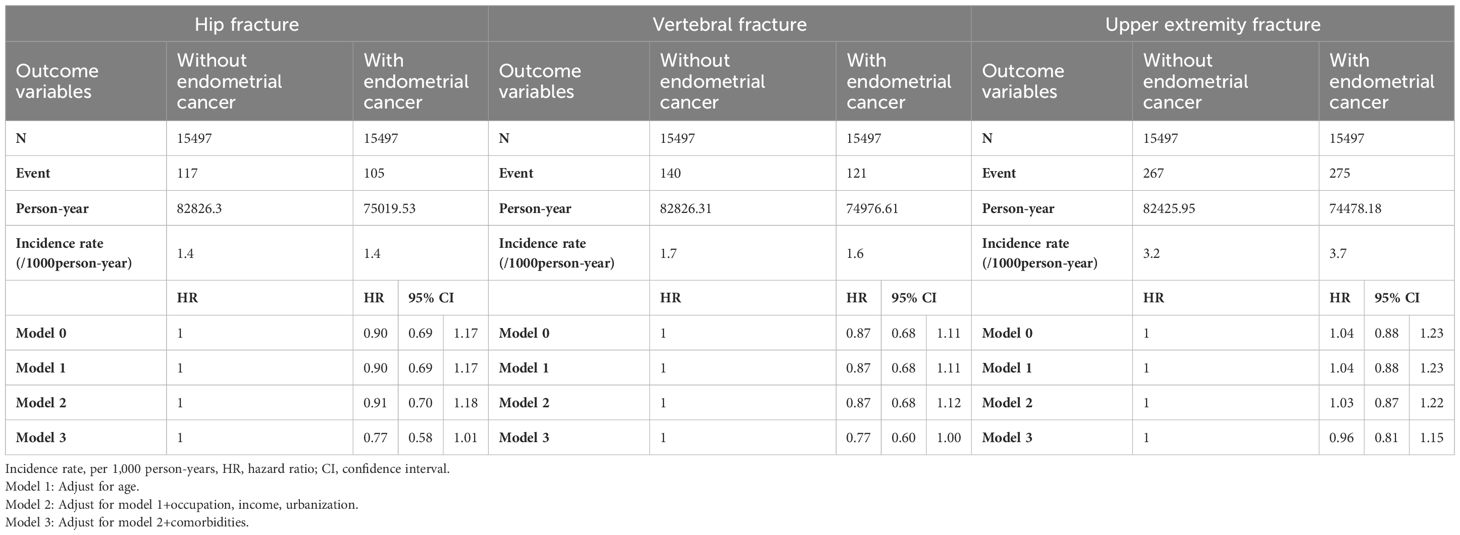
Table 1. The fracture event number, follow-up person-year, the incidence rate and the hazard ratio and 95% confidence interval in patients with and without endometrial cancer (competing risk).
Fracture risk among patients with EC with and without DM
Of the 15,505 patients with EC from 2007 to 2018, there were 3,044 patients with and 12,461 patients without DM. The mean age of patients with EC, but without DM was 53.6 years. On the other hand, the mean age of patients with EC and DM was 57.5 years (Table 2). Patients with EC and DM had a higher prevalence of CVD, CKD, and COPD. These patients also received more RT and chemotherapy than those without DM. Patients with stages 3, 4, and grade 3 had a higher proportion of DM. Patients with DM had more osteoporotic fracture events (8.71%) than those without DM (5.4%). The cumulative incidence of osteoporotic fracture (log-rank test: P < 0.001), hip fracture (log-rank test: P < 0.001), vertebral fracture (log-rank test: P < 0.001), and upper extremity fracture (log-rank test: P < 0.001) in patients with EC with and without DM were demonstrated in Figure 2. Patients with DM had a significantly higher risk of osteoporotic fracture (HR 1.29 [95% CI 1.08-1.55]) (Table 3), hip fracture (HR 2.37 [95% CI 1.44-3.92]), and vertebral fracture (HR 1.71 [95% CI 1.06-2.74]). Patients with DM had a no significant association of upper extremity fracture (HR 1.33 [95% CI 0.95-1.87]) after they were adjusted for comorbidities, cancer characteristics, and treatment. We used the Bonferroni test for adjustment for multiple comparisons, and the results were demonstrated in Supplementary Table S5. Factors associated with each kind of fracture in patients with EC and DM were demonstrated in Table 4. Only age was demonstrated to have a significant interaction effect on hip fracture. Comorbidities and cancer characteristics seemed to have no interaction effect on fractures.

Table 2. Baseline demographic factors and comorbidities of endometrial cancer patients with and without DM (osteoporotic fracture cohort).
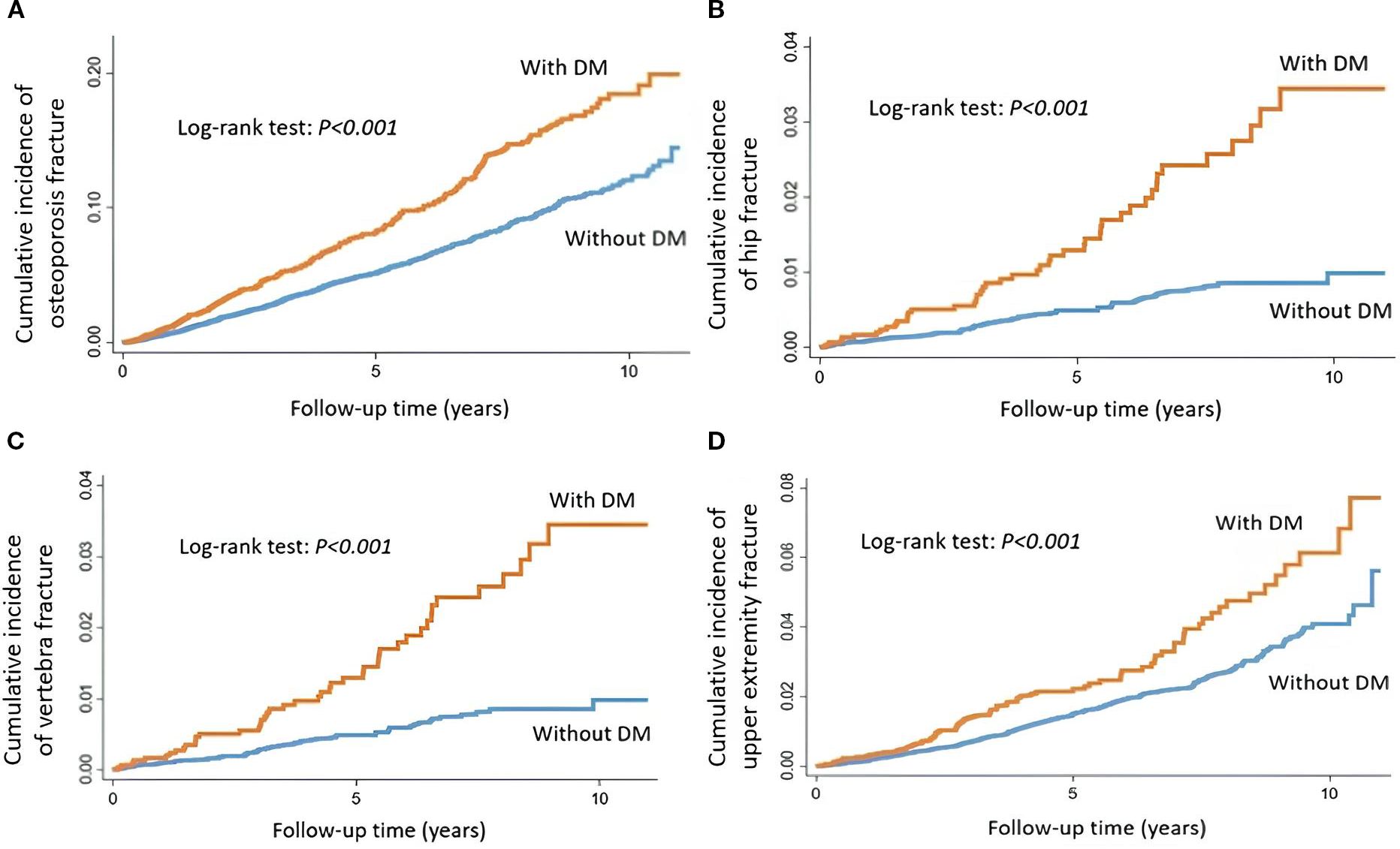
Figure 2. Cumulative incidence of (A) osteoporotic fracture, (B) hip fracture, (C) vertebral fracture, and (D) upper extremity fracture in endometrial cancer patients with and without DM.
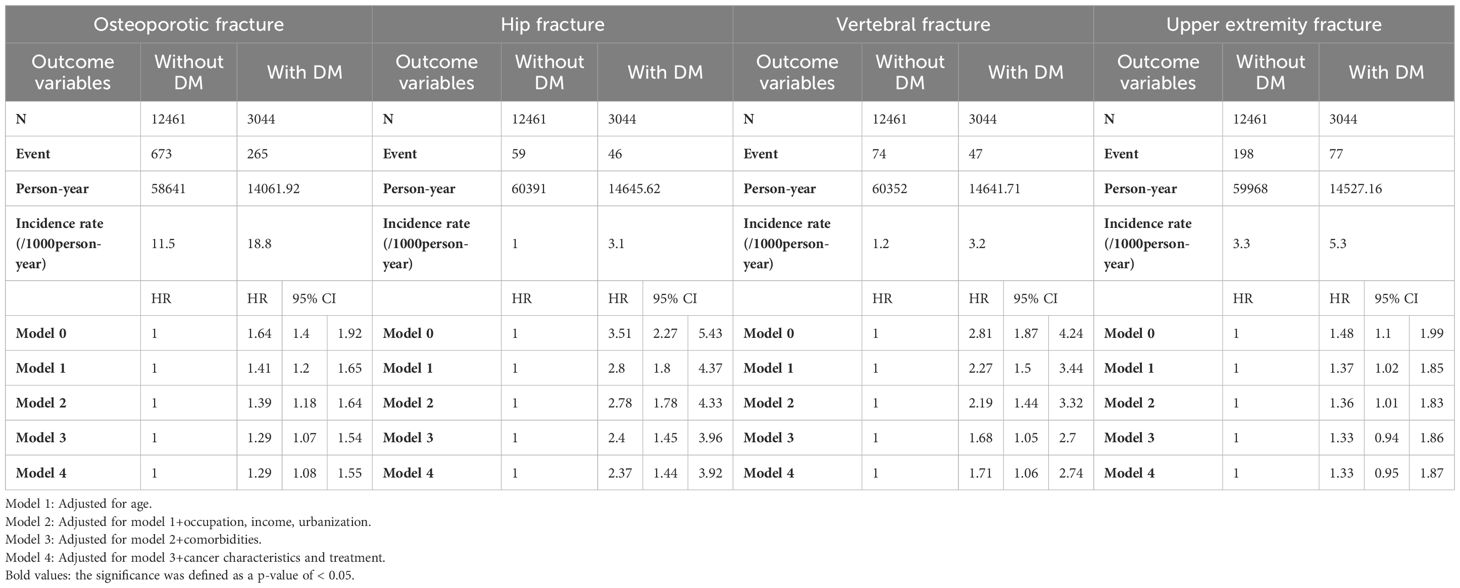
Table 3. The fracture event number, follow-up person-year, the incidence rate and the hazard ratio and 95% confidence interval in endometrial cancer patients with and without DM.
Sensitivity analysis
As for the 2011–2018 cohort, which added BMI as one of the covariates, baseline demographic factors and comorbidities of EC patients with and without DM were demonstrated in Supplementary Table S6. Most of the patients with DM had a BMI ≥25. Patients with EC and DM in the 2011–2018 cohort had a significantly higher incidence of osteoporosis fracture (log-rank test: P < 0.001) (Supplementary Figure S1). Patients with EC and DM in the 2011–2018 cohort had a significantly higher risk of osteoporotic fracture (HR 1.35 [95% CI 1.09–1.69]) (Supplementary Table S7).
Discussion
Our study showed that patients with EC had a no significant association of hip, vertebral, and upper extremity fractures when compared with the general population. In all patients with EC, those with DM had a significantly higher risk of osteoporotic fracture, hip fracture, and vertebral fracture than those without DM. Patients with DM had a no significant association of upper extremity fracture compared with those with EC but without DM.
The present study demonstrated that patients with EC had a no significant association of hip, vertebra and upper extremity fracture when compared to the general population, which was not consistent with another population-based study of 2111 patients with EC (20), which showed a reduced risk of hip fracture in EC patients. This study had fewer patients than the current study (20), and the patients were followed up starting at age 50 (20). The present study included all patients older than 20 years. The previous study also demonstrated that age was not a determinant of the risk of hip fracture (20). On the other hand, we found that patients with EC and DM or aged older than 65 years had a lower risk of hip fracture than patients without EC. Since DM and older age are both well-known risk factors for fractures (21), lower risk of hip fractures in patients with EC may be attributed to higher BMI in patients with EC in the present study (20). Again, when compared with the general population, the interaction effect on vertebral fracture risk differed within subgroups of age, DM, and COPD. The difference between the fracture risk of the hip and vertebra could be attributed to the early bone loss in the trabecular bone, but with increasing age, the bone loss is restricted to the cortical region (22). Vertebral fractures are more common in patients younger than 65 years, and hip fractures are more frequent in patients older than 65 years (22). Previous studies revealed that patients with DM were vulnerable to postural instability due to altered motion perception (11). In addition, severe hypoglycemia was associated with a greater prevalence of falls (23), which may also put patients with DM at risk of fractures. With respect to COPD, smoking (24), reduced physical activity (25), low body weight (26), sarcopenia (27), systemic inflammation (28), glucocorticoid (29), vitamin D deficiency (30), hypoxemia and hypercapnia (31, 32), and anemia (33) were all associated with a higher risk of fracture. When compared with the general population, the interaction effect on upper extremity fracture risk also differed within subgroups of age and COPD.
Our study indicated that when comparing EC patients with and without DM, only age was demonstrated to have a significant interaction effect on hip fracture. Comorbidities, cancer treatment and characteristics seemed to have no interaction effect on fractures. A previous study involving 40 patients with cervical cancer revealed that changes in BMD of the lumbar spine after pelvic RT were not significant (34). Nonetheless, another study with 557 patients with cervical cancer showed that those with higher age, lower body weight, and higher radiation dose may suffer from pelvic fracture (35). In addition, another study of 239 patients, of whom 73 patients were diagnosed with EC, found a significant decrease in BMD after pelvic RT (36). As observed in our study, since patients with DM were diagnosed with more advanced EC, they received more RT and chemotherapy. Those who did not receive adjuvant therapy may suffer more from other comorbidities that restrain them from receiving further treatment. The staging and grade of EC and the diagnosis of DM were not analyzed in previous studies (34–36). Our study showed that cancer staging and grade had no interaction effect on hip, vertebral, and upper extremity fractures. Previous research demonstrated that higher BMI, compared to lower individuals, had a protective effect against fracture incidence (20). In our sensitivity analysis, which added BMI as one of the covariates, patients with EC and DM still demonstrated a significantly higher risk of osteoporotic fracture than patients without DM.
The strength of this study lies in the fact that it uses the largest number of patients’ data to date. The study focused on the fracture risk of EC patients with or without DM. Longer follow-up periods strengthened our evidence compared to previous investigations. Additionally, we conducted subgroup analyses to account for potential confounders, further enhancing the robustness of our findings. There are several limitations acknowledged within the research. First, rather than a randomized control design, the present observational study lacked the sufficient causality between the fracture risk and EC patients with DM. However, the nationally population-based cohort study still demonstrated significant evidence. Second, we could not calculate the window of time in which the 3 outpatient fractures occurred, nor could we determine whether the patients had similar fracture sites or not. Third, hormone therapy in this study included bone-positive and bone-negative effect, which may misestimate the interaction effect of hormone therapy on fracture. Fourth, we only excluded patients with history of osteoporotic fractures because diagnosis of osteoporosis and use of osteoporosis medication may be underestimated by NHIRD. Fifth, there might be persistent unmeasured covariates, particularly concerning cancer characteristics with potential interactions, collinearity, or dependencies among variables related to cancer and its treatment (e.g., estrogen level, ER and PR status, staging, radiotherapy, chemotherapy, targeted therapy, and hormone therapy). Although the basic demographic characteristic and detailed cancer information, such as staging and treatment, were all adjusted in our full model, future studies can benefit from addressing these dependencies through more advanced statistical techniques or alternative study designs, such as calculating variance inflation factors (VIFs), examining correlation matrices, stratification on cancer staging or investigating interaction terms of hormone receptor status which may potential confound the fracture risk.
Conclusion
According to our study, patients with EC had a no significant association of fracture, while DM increased the fracture risk in patients with EC. Age had a significant interaction effect on fracture. Since there were several limitations in the present study, such as lacking more detailed treatment and cancer staging classification, the results should be interpreted cautiously and more comprehensive studies are still required.
Data availability statement
The original contributions presented in the study are included in the article/Supplementary Material. Further inquiries can be directed to the corresponding author.
Ethics statement
The studies involving humans were approved by The Mackay Memorial Hospital Institutional Review Board approved the study protocol (21MMHIS398e approved with exempt consents). The studies were conducted in accordance with the local legislation and institutional requirements. The ethics committee/institutional review board waived the requirement of written informed consent for participation from the participants or the participants’ legal guardians/next of kin because the information of the patients were not identifiable.
Author contributions
W-HT: Conceptualization, Investigation, Writing – original draft. M-SH: Data curation, Formal analysis, Methodology, Software, Writing – review & editing. C-SW: Conceptualization, Investigation, Methodology, Writing – review & editing. H-YH: Funding acquisition, Project administration, Resources, Writing – review & editing. C-TH: Funding acquisition, Project administration, Resources, Writing – review & editing. T-LY: Funding acquisition, Project administration, Resources, Writing – review & editing. K-LC: Supervision, Validation, Visualization, Writing – review & editing. C-CL: Supervision, Validation, Visualization, Writing – review & editing. M-NC: Supervision, Validation, Visualization, Writing – review & editing. M-CT: Conceptualization, Data curation, Formal Analysis, Funding acquisition, Investigation, Methodology, Writing – review & editing.
Funding
The author(s) declare financial support was received for the research and/or publication of this article. This paper was supported by grants from the Health Promotion Administration, Ministry of Science and Technology (MOST 110-2314-B-195-004) in Taiwan.
Conflict of interest
The authors declare that the research was conducted in the absence of any commercial or financial relationships that could be construed as a potential conflict of interest.
Generative AI statement
The author(s) declare that no Generative AI was used in the creation of this manuscript.
Any alternative text (alt text) provided alongside figures in this article has been generated by Frontiers with the support of artificial intelligence and reasonable efforts have been made to ensure accuracy, including review by the authors wherever possible. If you identify any issues, please contact us.
Publisher’s note
All claims expressed in this article are solely those of the authors and do not necessarily represent those of their affiliated organizations, or those of the publisher, the editors and the reviewers. Any product that may be evaluated in this article, or claim that may be made by its manufacturer, is not guaranteed or endorsed by the publisher.
Supplementary material
The Supplementary Material for this article can be found online at: https://www.frontiersin.org/articles/10.3389/fendo.2025.1570426/full#supplementary-material
References
1. Morice P, Leary A, Creutzberg C, Abu-Rustum N, and Darai E. Endometrial cancer. Lancet (London England). (2016) 387:1094–108. doi: 10.1016/S0140-6736(15)00130-0
2. Colombo N, Creutzberg C, Amant F, Bosse T, González-Martín A, Ledermann J, et al. ESMO-ESGO-ESTRO Consensus Conference on Endometrial Cancer: diagnosis, treatment and follow-up. Ann Oncol Off J Eur Soc Med Oncol. (2016) 27:16–41. doi: 10.1093/annonc/mdv484
3. Talhouk A, McConechy MK, Leung S, Yang W, Lum A, Senz J, et al. Confirmation of ProMisE: A simple, genomics-based clinical classifier for endometrial cancer. Cancer. (2017) 123:802–13. doi: 10.1002/cncr.30496
4. Mandato VD, Mastrofilippo V, Palicelli A, Silvotti M, Serra S, Giaccherini L, et al. Solitary vulvar metastasis from early-stage endometrial cancer: Case report and literature review. Medicine. (2021) 100:e25863. doi: 10.1097/MD.0000000000025863
5. Pfeilschifter J and Diel IJ. Osteoporosis due to cancer treatment: pathogenesis and management. J Clin Oncol Off J Am Soc Clin Oncol. (2000) 18:1570–93. doi: 10.1200/JCO.2000.18.7.1570
6. Guise TA. Bone loss and fracture risk associated with cancer therapy. Oncol. (2006) 11:1121–31. doi: 10.1634/theoncologist.11-10-1121
7. Lee JE, Park CY, Lee E, and Ji YI. Effect of gynecological cancer and its treatment on bone mineral density and the risk of osteoporosis and osteoporotic fracture. Obstetr Gynecol Sci. (2020) 63:470–9. doi: 10.5468/ogs.20012
8. Han J, Zhang L, Guo H, Wysham WZ, Roque DR, Willson AK, et al. Glucose promotes cell proliferation, glucose uptake and invasion in endometrial cancer cells via AMPK/mTOR/S6 and MAPK signaling. Gynecol Oncol. (2015) 138:668–75. doi: 10.1016/j.ygyno.2015.06.036
9. Jiang N and Xia W. Assessment of bone quality in patients with diabetes mellitus. Osteoporosis Int. (2018) 29:1721–36. doi: 10.1007/s00198-018-4532-7
10. Rubin MR and Patsch JM. Assessment of bone turnover and bone quality in type 2 diabetic bone disease: current concepts and future directions. Bone Res. (2016) 4:16001. doi: 10.1038/boneres.2016.1
11. La Scaleia B, Siena A, D’Onofrio L, Celli A, Capuzzi G, Latino A, et al. Deterioration of vestibular motion perception: A risk factor for postural instability and falls in elderly with type 2 diabetes. Diabetes Metab Res Rev. (2024) 40:e3845. doi: 10.1002/dmrr.3845
12. Lin WQ, Liao YX, Wang JY, Luo LY, Yuan LX, Sun SY, et al. Associations between type 2 diabetes mellitus and risk of falls among community-dwelling elderly people in Guangzhou, China: a prospective cohort study. BMC Geriatr. (2024) 24:717. doi: 10.1186/s12877-024-05314-5
13. Tsai TF, Huang YH, Wei CY, Ng KJ, Newson RS, Lee TH, et al. Epidemiology, treatment patterns, and healthcare resource utilization study of patients with alopecia areata in Taiwan’s national health insurance research database. Value Health Reg Issues. (2024) 43:101007. doi: 10.1016/j.vhri.2024.101007
14. Chung CH, Wang YJ, and Lee CY. One-year healthcare utilization and expenditures among patients with clinically significant mitral regurgitation in Taiwan. Cardiol Ther. (2023) 12:159–69. doi: 10.1007/s40119-022-00294-2
15. Lello S, Capozzi A, and Scambia G. Osteoporosis and cardiovascular disease: an update. Gynecol Endocrinol. (2015) 31:590–4. doi: 10.3109/09513590.2015.1041908
16. McGuigan FE and Malmgren L. Bone health as a co-morbidity of chronic kidney disease. Best Pract Res Clin Rheumatol. (2022) 36:101760. doi: 10.1016/j.berh.2022.101760
17. Li Y, Gao H, Zhao L, and Wang J. Osteoporosis in COPD patients: Risk factors and pulmonary rehabilitation. Clin Respir J. (2022) 16:487–96. doi: 10.1111/crj.13514
18. Weiss RJ, Wick MC, Ackermann PW, and Montgomery SM. Increased fracture risk in patients with rheumatic disorders and other inflammatory diseases – a case-control study with 53,108 patients with fracture. J Rheumatol. (2010) 37:2247–50. doi: 10.3899/jrheum.100363
19. Noroozzadeh M, Amiri M, Farhadi-Azar M, and Ramezani Tehrani F. Bone health in women with polycystic ovary syndrome: A narrative review. J Clin Densitometry: Off J Int Soc Clin Densitometry. (2022) 25:606–14. doi: 10.1016/j.jocd.2022.02.005
20. Persson I, Naessén T, Adami HO, Bergström R, Lagrelius A, Möllerström G, et al. Reduced risk of hip fracture in women with endometrial cancer. Int J Epidemiol. (1992) 21:636–42. doi: 10.1093/ije/21.4.636
21. Ensrud KE. Epidemiology of fracture risk with advancing age. J Gerontol Ser A Biol Sci Med Sci. (2013) 68:1236–42. doi: 10.1093/gerona/glt092
22. Osterhoff G, Morgan EF, Shefelbine SJ, Karim L, McNamara LM, and Augat P. Bone mechanical properties and changes with osteoporosis. Injury. (2016) 47 Suppl 2:S11–20. doi: 10.1016/S0020-1383(16)47003-8
23. Moffet HH, Huang ES, Liu JY, Parker MM, Lipska KJ, Laiteerapong N, et al. Severe hypoglycemia and falls in older adults with diabetes: The Diabetes & Aging Study. Diabetes Epidemiol Manag. (2023) 12:100162. doi: 10.1016/j.deman.2023.100162
24. Yang CY, Cheng-Yen Lai J, Huang WL, Hsu CL, and Chen SJ. Effects of sex, tobacco smoking, and alcohol consumption osteoporosis development: Evidence from Taiwan biobank participants. Tobacco Induced Dis. (2021) 19:52. doi: 10.18332/tid/136419
25. Yuan Y, Chen X, Zhang L, Wu J, Guo J, Zou D, et al. The roles of exercise in bone remodeling and in prevention and treatment of osteoporosis. Prog Biophysics Mol Biol. (2016) 122:122–30. doi: 10.1016/j.pbiomolbio.2015.11.005
26. Lin CW, Chen YY, Chen YJ, Liang CY, Lin MS, and Chen W. Prevalence, risk factors, and health-related quality of life of osteoporosis in patients with COPD at a community hospital in Taiwan. Int J Chronic Obstruct Pulmonary Dis. (2015) 10:1493–500. doi: 10.2147/COPD.S85432
27. Jang SY, Park J, Ryu SY, and Choi SW. Low muscle mass is associated with osteoporosis: A nationwide population-based study. Maturitas. (2020) 133:54–9. doi: 10.1016/j.maturitas.2020.01.003
28. Liang B and Feng Y. The association of low bone mineral density with systemic inflammation in clinically stable COPD. Endocrine. (2012) 42:190–5. doi: 10.1007/s12020-011-9583-x
29. Compston J. Glucocorticoid-induced osteoporosis: an update. Endocrine. (2018) 61:7–16. doi: 10.1007/s12020-018-1588-2
30. Janssens W, Bouillon R, Claes B, Carremans C, Lehouck A, Buysschaert I, et al. Vitamin D deficiency is highly prevalent in COPD and correlates with variants in the vitamin D-binding gene. Thorax. (2010) 65:215–20. doi: 10.1136/thx.2009.120659
31. Gorissen B, de Bruin A, Miranda-Bedate A, Korthagen N, Wolschrijn C, de Vries TJ, et al. Hypoxia negatively affects senescence in osteoclasts and delays osteoclastogenesis. J Cell Physiol. (2018) 234:414–26. doi: 10.1002/jcp.26511
32. Chen D, Li Y, Zhou Z, Wu C, Xing Y, Zou X, et al. HIF-1α inhibits Wnt signaling pathway by activating Sost expression in osteoblasts. PloS One. (2013) 8:e65940. doi: 10.1371/journal.pone.0065940
33. Fujimoto H, Fujimoto K, Ueda A, and Ohata M. Hypoxemia is a risk factor for bone mass loss. J Bone Mineral Metab. (1999) 17:211–6. doi: 10.1007/s007740050087
34. Chen HH, Lee BF, Guo HR, Su WR, and Chiu NT. Changes in bone mineral density of lumbar spine after pelvic radiotherapy. Radiother Oncol. (2002) 62:239–42. doi: 10.1016/S0167-8140(02)00002-6
35. Oh D, Huh SJ, Nam H, Park W, Han Y, Lim DH, et al. Pelvic insufficiency fracture after pelvic radiotherapy for cervical cancer: analysis of risk factors. Int J Radiat Oncol Biol Physics. (2008) 70:1183–8. doi: 10.1016/j.ijrobp.2007.08.005
Keywords: endometrial cancer, diabetes, hip fracture, vertebral fracture, extremity fracture
Citation: Tsai W-H, Hsu M-S, Weng C-S, Hsu H-Y, Hsieh C-T, Yeh T-L, Chien K-L, Lee C-C, Chien M-N and Tsai M-C (2025) Association between endometrial cancer and subsequent risk of fracture: a national cohort study. Front. Endocrinol. 16:1570426. doi: 10.3389/fendo.2025.1570426
Received: 13 February 2025; Accepted: 15 September 2025;
Published: 07 October 2025.
Edited by:
Alberto Falchetti, Santa Maria della Misericordia, ItalyReviewed by:
Kagaku Azuma, Heisei College of Health Sciences, JapanNour Massouh, American University of Beirut, Lebanon
Copyright © 2025 Tsai, Hsu, Weng, Hsu, Hsieh, Yeh, Chien, Lee, Chien and Tsai. This is an open-access article distributed under the terms of the Creative Commons Attribution License (CC BY). The use, distribution or reproduction in other forums is permitted, provided the original author(s) and the copyright owner(s) are credited and that the original publication in this journal is cited, in accordance with accepted academic practice. No use, distribution or reproduction is permitted which does not comply with these terms.
*Correspondence: Ming-Chieh Tsai, cjA3ODQ5MDM2QG50dS5lZHUudHc=
 Wen-Hsuan Tsai
Wen-Hsuan Tsai Min-Shu Hsu2
Min-Shu Hsu2 Hsin-Yin Hsu
Hsin-Yin Hsu Kuo-Liong Chien
Kuo-Liong Chien